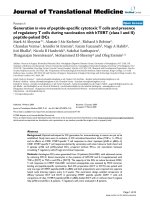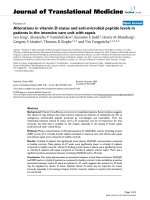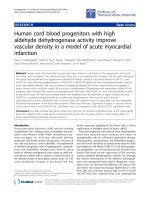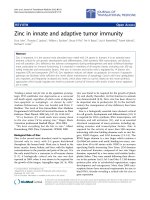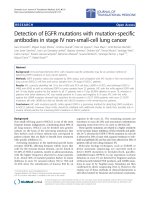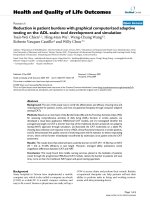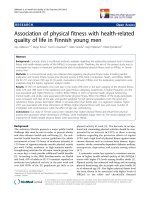báo cáo hóa học: " Reduction in patient burdens with graphical computerized adaptive testing on the ADL scale: tool development and simulation" doc
Bạn đang xem bản rút gọn của tài liệu. Xem và tải ngay bản đầy đủ của tài liệu tại đây (623.37 KB, 6 trang )
BioMed Central
Page 1 of 6
(page number not for citation purposes)
Health and Quality of Life Outcomes
Open Access
Research
Reduction in patient burdens with graphical computerized adaptive
testing on the ADL scale: tool development and simulation
Tsair-Wei Chien
1,2
, Hing-Man Wu
1
, Weng-Chung Wang
†3
,
Roberto Vasquez Castillo
4
and Willy Chou*
1
Address:
1
Department of Rehabilitation, Chi-Mei Medical Center, Taiwan, ROC,
2
Department of Hospital and Health Care Administration, Chia-
Nan University of Pharmacy and Science, Tainan, Taiwan, ROC,
3
Department of Educational Psychology, Counseling and Learning Needs, Hong
Kong Institute of Education, Hong Kong and
4
Director SILAIS, Carazo, Nicaragua, Central America
Email: Tsair-Wei Chien - ; Hing-Man Wu - ; Weng-Chung Wang - ;
Roberto Vasquez Castillo - ; Willy Chou* -
* Corresponding author †Equal contributors
Abstract
Background: The aim of this study was to verify the effectiveness and efficacy of saving time and
reducing burden for patients, nurses, and even occupational therapists through computer adaptive
testing (CAT).
Methods: Based on an item bank of the Barthel Index (BI) and the Frenchay Activities Index (FAI)
for assessing comprehensive activities of daily living (ADL) function in stroke patients, we
developed a visual basic application (VBA)-Excel CAT module, and (1) investigated whether the
averaged test length via CAT is shorter than that of the traditional all-item-answered non-adaptive
testing (NAT) approach through simulation, (2) illustrated the CAT multimedia on a tablet PC
showing data collection and response errors of ADL clinical functional measures in stroke patients,
and (3) demonstrated the quality control of endorsing scale with fit statistics to detect responding
errors, which will be further immediately reconfirmed by technicians once patient ends the CAT
assessment.
Results: The results show that endorsed items could be shorter on CAT (M = 13.42) than on NAT
(M = 23) at 41.64% efficiency in test length. However, averaged ability estimations reveal
insignificant differences between CAT and NAT.
Conclusion: This study found that mobile nursing services, placed at the bedsides of patients
could, through the programmed VBA-Excel CAT module, reduce the burden to patients and save
time, more so than the traditional NAT paper-and-pencil testing appraisals.
Background
Many hospitals in Taiwan have implemented a mobile
computer cart, which is also called a computer on wheels
(COW) or a tablet PC. It is small, compact, wireless, and
easy to fit a ward. Nurses or physicians can easily roll up a
COW to access charts and perform their rounds. Besides,
occupational therapists can help patients self-rate their
ability to perform tasks in living and working environ-
ments with this promising device.
Published: 5 May 2009
Health and Quality of Life Outcomes 2009, 7:39 doi:10.1186/1477-7525-7-39
Received: 14 February 2009
Accepted: 5 May 2009
This article is available from: />© 2009 Chien et al; licensee BioMed Central Ltd.
This is an Open Access article distributed under the terms of the Creative Commons Attribution License ( />),
which permits unrestricted use, distribution, and reproduction in any medium, provided the original work is properly cited.
Health and Quality of Life Outcomes 2009, 7:39 />Page 2 of 6
(page number not for citation purposes)
The Motion C5 [1], also known as the mobile clinical
assistant (MCA), which integrates technology from Intel
®
Health, not only brings reliable, automated, patient data
management directly to the point of care, but also com-
bines and increases productivity and improves overall
quality of care. Although many studies [2,3] have
addressed the fact that clinicians and medical staff prefer
a tablet PC over a mobile cart with a laptop computer for
supporting electronic clinical documentation, it is of
interest to study whether computerized adaptive testing
(CAT), based on item response theory (IRT) [4], could fur-
ther enrich the advantage of using a tablet PC in evaluat-
ing patients' activities of daily living (ADL) functions.
There are many clinical functional scales, such as the Bar-
thel Index, Frenchay Activities Index, Functional Inde-
pendence Measure, Berg Balance Scale, Fugl-Meyer Motor
Assessment Scale, Wolf Motor Function Test, Stroke
Impact Scale and others. The psychometric properties of
these scales are often investigated using classic test theory
where a raw score is generally used to describe a patient's
level of ADL function. CAT, based on IRT, is a method of
administering tests that adapts to an examinee's latent
trait level. CAT can save time and alleviate burden to
patients and technicians than traditional non-adaptive
paper-and-pencil or computerized-based assessments [5-
7]. CAT has attracted many researchers' attention because
it has a better control of item exposure and a less cost con-
sumption on item development in medical and health-
care professions.
Purposes
The aim of this study is to verify how CAT can save time
and reduce burden for patients and technicians, through
the following three steps: (a) A simulation study was con-
ducted to justify that CAT needs a shorter test length than
traditional non-adaptive testing(NAT) to achieve a similar
degree of measurement precision; (b) A graphical CAT
multimedia on a tablet PC was demonstrated to collect
data of ADL clinical functional measures in stroke
patients; (c) The quality control fit statistics and unex-
pected standardized residuals derived from Rasch analysis
[8] was used to detect responding errors, which were fur-
ther immediately reconfirmed by technicians with regard
to patient's response.
Methods
1. Activities of daily living
ADL is defined by the MedicineNet.com Medical Diction-
ary as "the thing we normally do in daily living including
any daily activity we perform for self-care (such as feeding
ourselves, bathing, dressing, grooming), work, homemak-
ing, and leisure." The evaluation for ADL includes physi-
cal and mental skills. In the area of physical or
occupational therapy, ADL reflects how well a disabled
patient or individual recovering from a disease or an acci-
dent can function in daily life. It is also used to determine
how well patients relate and participate in their environ-
ment.
2. Basic ADL versus Instrumental ADL
Basic ADL evaluated by the Barthel Index (BI) are those
skills needed in typical daily self care. An evaluation
would, in part, consist of bathing, dressing, feeding, and
toileting. On the other hand, instrumental ADL refers to
skills beyond basic self care that evaluates how individu-
als function within their homes, workplaces, and social
environments. Instrumental ADL may include typical
domestic tasks, such as driving, cleaning, cooking, and
shopping, as well as other less physically demanding
tasks, such as operating electronic appliances and han-
dling budgets.
Hsueh et al. [9] stated that basic ADL does not capture sig-
nificant losses in higher levels of physical function or
activities that are necessary for independence in the home
and community [10]. Several authors [5,11] recommend
combining basic ADL and instrumental ADL to compre-
hensively measure ADL function and avoid a ceiling effect
exhibited in the BI and a floor effect exhibited in the
Frenchay Activities Index (FAI; measuring IADL) [5,11].
Such a combined scale is expected to be more responsive
and have a wider range than either of the individual meas-
urements [12,13].
3. The combination of BI & FAI
Hsueh and his colleagues [9] performed Rasch analysis to
link the BI and FAI into a combined scale using the WIN-
STEPS software [14] (Linacre, 2007), which is one of the
most widely used programs for Rasch measurement [15].
The partial credit model [16] in which each item has a
unique rating scale structure [17] was fit to the data. The
middle response category was collapsed due to disordered
steps and simplicity. Two items were removed because of
poor fit. The final version of the combined scale consisted
of 23 dichotomous items.
4. Data source and generation
We used these 23 dichotomous items, shown in Table 1,
to build an item bank to assess comprehensive ADL func-
tion in stroke patients. We programmed a VBA-Excel CAT
module to (a) gather simulation data, (b) verify that CAT
only needs a shorter test length to achieve the same meas-
urement precision as non-adaptive testing, (c) illustrate
how a tablet PC works graphically, and (d) report how the
Rasch-specific quality control helps detect aberrant
responses to ensure measurement quality.
As in Hsueh et al. [9], we simulated 1,000 persons from a
normal distribution with mean 1.17 and standard devia-
Health and Quality of Life Outcomes 2009, 7:39 />Page 3 of 6
(page number not for citation purposes)
tion 3.94. Treating the parameters in Table 1 as true val-
ues, we simulated a data set of 1,000 × 23 according to the
Rasch dichotomous model. This whole data set, represent-
ing NAT, was treated as a base-line so that the perform-
ance of CAT can be assessed. It was expected that CAT,
with a shorter test length, can achieve a similar degree of
measurement precision as NAT.
5. IRT-based CAT
We programmed a VBA module in Microsoft Excel in
compliance with the flowchart in Figure 1. It has been
found [9] that the person separation reliability (similar to
Cronbach's alpha) was .94, and the persons followed a
normal distribution with mean 1.17 and standard devia-
tion 3.94. Under such a case, the mean standard error
measurement across persons was 0.965, which served as
the stopping rule of CAT.
There are three major concepts in CAT
(1). Individual measures estimated in CAT
The first step in CAT is to estimate individual person
measure, which is often done by locating the maximum of
the log-likelihood function for person measure using an
iterative Newton-Raphson procedure [17]. This algorithm
searches for the mode (rather than the mean) of each per-
son's log-likelihood function through iteratively minimiz-
ing the ratio of first over second derivatives of the log-
likelihood function. The provisional person measure is
derived at individual iterations (or CAT steps) by the pre-
vious estimation minus its converged rate. Interested read-
ers can refer to the textbook of Item Response Theory for
Psychologists [17] or visit website at http://www.
eddata.com/resources/publications/
EDS_Rasch_Demo.xls for detailed CAT procedure.
Table 1: Combined 23 items of BI & FAI
No. Items Difficulty SE
1 FAI13: household/car maintenance 4.73 0.31
2 FAI14: reading books 4.72 0.31
3 FAI15: gainful work 4.01 0.26
4 FAI12: gardening 3.75 0.25
5 FAI9: actively pursuing hobbies 3.53 0.24
6 FAI11: travel outings/car rides 3.52 0.24
7 FAI1: preparing main meals 3.24 0.23
8 FAI3: washing clothes 3.19 0.23
9 FAI2: washing up 3.09 0.22
10 FAI5: heavy housework 2.75 0.22
11 FAI4: light housework 1.95 0.21
12 FAI10: driving a car/bus travel 1.83 0.2
13 FAI6: local shopping 0.59 0.21
14 BI2: bathing 0.55 0.21
15 BI10: stairs -0.72 0.22
16 BI4: dressing -0.77 0.22
17 BI9: mobility -2.85 0.26
18 BI7: toileting -3.48 0.27
19 BI8: transfer -3.99 0.27
20 BI3: grooming -6.77 0.32
21 BI6: bladder control -7.09 0.34
22 BI5: bowel control -7.33 0.35
23 BI1: feeding -8.41 0.44
Mean 0 0.26
SD 4.19 0.06
Procedure and flowchart of CATFigure 1
Procedure and flowchart of CAT.
Health and Quality of Life Outcomes 2009, 7:39 />Page 4 of 6
(page number not for citation purposes)
(2) Person SE controlled in CAT to attain its desirable test reliability
The second step in CAT is to assure appropriate measure-
ment precision. As stated above, the standard error of
measurement (SEM) was set at 0.965, in order to achieve
a test reliability of .94, as shown in the flowchart in Figure
1. SEM is a function of the summation of item informa-
tion for those items that have been administered. The next
item to be administered is the item in the item bank that
provides the highest information about the person meas-
ure.
(3) Multimedia CAT along the patient bedside
The third step in CAT is the application in healthcare set-
tings. The VBA-Excel based CAT module demonstrates
how those unidimensional 23 items can assess compre-
hensive ADL function in stroke patients and how the
unexpected response with a Z-score beyond ± 2 [18] could
be examined as patient made questionable responses, to
which needs highly alert or even to redo them for guaran-
teeing the quality of endorsement.
Results
Efficiency of CAT
Among the 1,000 simulated persons, 826 had neither a
zero nor a perfect raw score. As shown in Table 2, CAT did
not yield person measure estimates that were statistically
different from non-adaptive testing (p = .78); and CAT
had a shorter test length than NAT (p < .01). NAT took all
the 23 items, whereas CAT took an average test length of
13.42 items. Thus, the efficiency of CAT was supported.
Each round of a CAT test can save at least five minutes to
both patient and occupational therapist, and can reach a
much more accurate set of responses through outline Z-
score examination than NAT.
CAT on a tablet PC in healthcare settings
(1) Provisional person measure
To demonstrate ADL assessment by CAT on a tablet PC,
we show in Table 3 the item selection procedures and the
stopping rules. At the beginning, a randomly selected item
(e.g., FAI6 with difficulty 0.59) was administered to a per-
son whose provisional person measure was set at zero.
The simulated response was "fail" (scored as 0) and an
easier item (i.e., BI4 with difficulty -0.77) was adminis-
tered. The simulated response was "passed" (scored as 1).
Since there were both "pass" and "fail", the person meas-
ure can be updated through the Newton-Raphson itera-
tion approach [17], which was 0.21, with SEM 2.43 at step
2.
(2) Item selection and stop criterion
Given a provisional person measure of 0.21, the next item
to be administered was the one that provided the highest
information about the person, which was BI2 with 0.55.
The simulated response was "passed" and the person
measure was updated as 0.87 with SEM 1.86 at step 3. This
procedure repeated until step 7 where FAI2 with difficulty
3.09 was administered and the updated person measure
was 2.65 with SEM 0.96. CAT stopped because SEM was
smaller than the criterion of 0.965.
(3) Aberrant responses examined by Z-score
1. Graphical multimedia CAT along the patient bedside
The screenshot of the CAT implementation on a tablet PC
is shown in Figure 2. Linacre [19] stated that a person
would be deemed a severe aberrant responder to the test
when the outfit mean square error (MNSQ) is greater than
2.0 together with a Z beyond ± 2 (the expected outfit
MNSQ is 1 for a good fit [20]). An occupational therapist
can use this statistic to check whether the response pattern
is aberrant. If not so like the illustrator of Outfit MNSQ
1.07 on the upper-right corner in Figure 3, one then has
confidence that the responses can reveal valuable infor-
mation about the respondent
2. Outline aberrant responses examined by Z-score
In Figure 3, one can easily observe that the person with
ability 2.30 failed on item 13 with difficulty 0.59, as
shown in the upper-left of Figure 3. This was an aberrant
response because the probability of success for such a per-
son on such an item was as high as .90. Another aberrant
response was found on the lower-right of Figure 3, where
the person passed item 4 unexpectedly because the prob-
ability of success on that item was as low as .20.
Figure 3 can be plotted on the screen of the tablet PC once
the patient completes the CAT. The patient in this case
might be required to complete these two tasks again in
Table 2: Comparison of CAT and non-adaptive testing (NAT) in measurement efficiency with the t-test
Mean Variance Observed Maximum Minimum p-value
Estimated Ability:
NAT -0.23 9.19 826 5.22 -8.62 .78
CAT -0.20 8.92 826 4.76 -8.62
Test length:
NAT 23 0 826 23 23 < .001
CAT 13.42 62.04 826 23 5
Health and Quality of Life Outcomes 2009, 7:39 />Page 5 of 6
(page number not for citation purposes)
order to submit accurate responses to the healthcare data-
base.
Discussion
The item bank was chosen from Hsueh et al. [9] which
measures ADL for stoke patients. We successfully devel-
oped a VBA-Excel CAT module and demonstrated how
CAT can be used to reduce patient and proxy burdens, and
improve data collection and quality measurement.
Through simulations, it was found that CAT can save up
to 42% of test length and achieve a very similar degree of
measurement precision as NAT. This is consistent with the
literature [5-7]. This study also found that mobile nursing
services along the bedsides of patients, through the pro-
grammed VBA-Excel graphical CAT module, is much less
burdensome to patients and time saving than traditional
NAT appraisals.
IRT-based CAT algorithms have been developed in educa-
tional testing for several decades and much is known
about their functioning in comparison to NAT [6,22,23].
CAT utilizes the invariance property under the Rasch or
IRT models to create an algorithm by which each person
receives a test that is tailored to the person's level so that
the questions are neither too difficult nor too easy and
usually contain fewer items than conventional non-adap-
tive measures [19].
Conclusion
Mobile nursing services through the programmed VBA-
Excel CAT module can reduce the burden to patients and
proxies and save time, more so than the traditional non-
adaptive assessing appraisals. With the networking and
rapidly growing mobile point of care development in hos-
pitals, IRT-based assessing appraisal is more in line with
real-world test, especially used in healthcare. We expect
that over the years this mobile framework of graphical
Table 3: A case of the CAT responding process (Yes = 1, No = 0) with a sequence of item selection.
Step Response Ability SEM Items Difficulty
1 0 - 2.77 FAI6: local shopping 0.59
2 1 0.21 2.43 BI4: dressing -0.77
3 1 0.87 1.86 BI2: bathing 0.55
4 1 1.76 1.39 FAI10: driving a car/bus travel 1.83
5 1 2.42 1.15 FAI4: light housework 1.95
6 1 3.07 1.00 FAI5: heavy housework 2.75
7 0 2.65 0.96 FAI2: washing up 3.09
CAT implemented on a tablet PCFigure 2
CAT implemented on a tablet PC.
Z-scores scatter diagram for the items to which the exami-nee respondedFigure 3
Z-scores scatter diagram for the items to which the
examinee responded. Note. *p < .05; item
number(observed score): Z-score. XXX: person estimation
equal to ln(P/(1-P) = ln(.9/.1) = ln(9) = 2.3 logits.
Publish with BioMed Central and every
scientist can read your work free of charge
"BioMed Central will be the most significant development for
disseminating the results of biomedical research in our lifetime."
Sir Paul Nurse, Cancer Research UK
Your research papers will be:
available free of charge to the entire biomedical community
peer reviewed and published immediately upon acceptance
cited in PubMed and archived on PubMed Central
yours — you keep the copyright
Submit your manuscript here:
/>BioMedcentral
Health and Quality of Life Outcomes 2009, 7:39 />Page 6 of 6
(page number not for citation purposes)
CAT assessing patient ADL as piloted in this study will
draw more research attention.
List of abbreviations
CAT: computerized adaptive testing; IRT: all answered
items; CTT: classic test theory; AAL: all answered items;
VBA: visual basic for application; ADL: activities of daily
living; COW: computer on wheels; MCA: mobile clinical
assistant; MNSQ: mean square errors; ZSTD: Z-standard-
ized; SEM: standard error measurement.
Competing interests
The authors declare that they have no competing interests.
Authors' contributions
TC collected all data and built up the database, designed
and performed the statistical analysis and wrote the man-
uscript. HW and WW contributed to the development of
the study design and advised about the performance of
the statistical analysis. WW contributed to the revision of
manuscript. The analysis and results were discussed with
the five authors together. HW, WW, RC and WC revised
the manuscript critically several times. WW advised the
CAT programming, helped with interpreting the results
and helped to draft the manuscript. All authors read and
approved the final manuscript.
Acknowledgements
We thank Chi-Mei Medical Center(Taiwan) for offering IT environment and
WW for his statistical advises and for his help with the interpretation of
data.
References
1. Motion C5: Improving Quality of Care and Nursing Workflow:
A Clinician Usability Pilot of the Motion Mobile Clinical
Assistant. 2007.
2. Krogh PR, Rough S, Thomley S: Comparison of two personal-
computer-based mobile devices to support pharmacists'
clinical documentation. Am J Health Syst Pharm 2008, 15,
65(2):154-7.
3. Wu M, Rhyner PM, Thao C, Kraniak L, Cronk C, Cruise K: A tablet-
PC application for the individual family service plan (IFSP). J
Med Syst 2007, 31(6):537-41.
4. Lord FM: Applications of item response theory to practical
testing problems. Hillsdale, NJ: Lawrence Erlbaum; 1980.
5. Pedersen PM, Jorgensen HS, Nakayama H, Raaschou HO, Olsen TS:
Comprehensive assessment of activities of daily living in
stroke: the Copenhagen Stroke Study. Arch Phys Med Rehabil
1997, 78:161-165.
6. Wainer HW, Dorans NJ, Flaugher R, Green BF, Mislevy RJ, Steinberg
L, Thissen D: Computerized adaptive testing: A primer. Hills-
dale, NJ: Erlbaum; 1990.
7. Weiss DJ, Mcbride JR: Bias and information of Bayesian adap-
tive testing. Applied Psychological Measurement 1984, 8(3):273-285.
8. Rasch G: Probabilistic models for some Intelligence and
attainment tests. Chicago: University of Chicago Press; 1960.
9. Hsueh IP, Wang WC, Sheu CF, Hsieh CL: Rasch analysis of com-
bining two indices to assess comprehensive ADL function in
stroke patients. Stroke 2004, 35:721-726.
10. Kelly-Hayes M, Robertson JT, Broderick JP, Duncan PW, Hershey LA,
Roth EJ, Thies WH, Trombly CA: The American Heart Associa-
tion stroke outcome classification. Stroke 1998, 29:1274-1280.
11. Hsieh CL, Hsueh IP: A cross-validation of the comprehensive
assessment of activities of daily living after stroke. cand J Reha-
bil Med 1999, 31:83-88.
12. Duncan PW, Lai SM, Bode RK, Perera S, DeRosa J: Stroke Impact
Scale-16: a brief assessment of physical function. Neurology
2003, 60:291-296.
13. Lai SM, Perera S, Duncan PW, Bode R: Physical and social func-
tioning after stroke: comparison of the Stroke Impact Scale
and Short Form-36. Stroke 2003, 34:488-493.
14. Linacre JM: WINSTEPS [computer program]. Chicago, IL [http:/
/www.winsteps.com].
15. Wang W-C, Chen C-T: Item parameter recovery, standard
error estimate and fit statistics of the WINSTEPS program
for the family of Rasch models. Educational and Psychological
Measurement 65:376-404.
16. Wright BD, Masters GN: Rating acale analysis. Chicago, Ill: MESA
Press; 1982.
17. Embretson S, Reise S: Item Response Theory for Psychologists.
Volume Chapter 7. L. NJ: Erlbaum Mahwah; 2000.
18. Linacre JM: Comparing "Partial Credit" and "Rating Scale"
Models. Rasch Measurement Transactions 2000, 14(3):768.
19. Linacre JM: Optimizing rating scale category effectiveness. J
Appl Meas 2002, 3(1):85-106.
20. Wright BD, Linacre M: Reasonable Mean-square Fit Values.
Rasch Measurement Transactions 1994, 8:3.
21. Wright BD, Mok M: Rasch models overview. J Appl Meas 2000,
1:83-106.
22. Weiss DJ: Improvement measurement quality and efficiency
with adaptive testing. Applied Psychological Measurement 1982,
6:473-492.
23. Weiss DJ: Adaptive testing by computer. Journal of Consulting and
Clinical Psychology 1985, 3:774-789.


